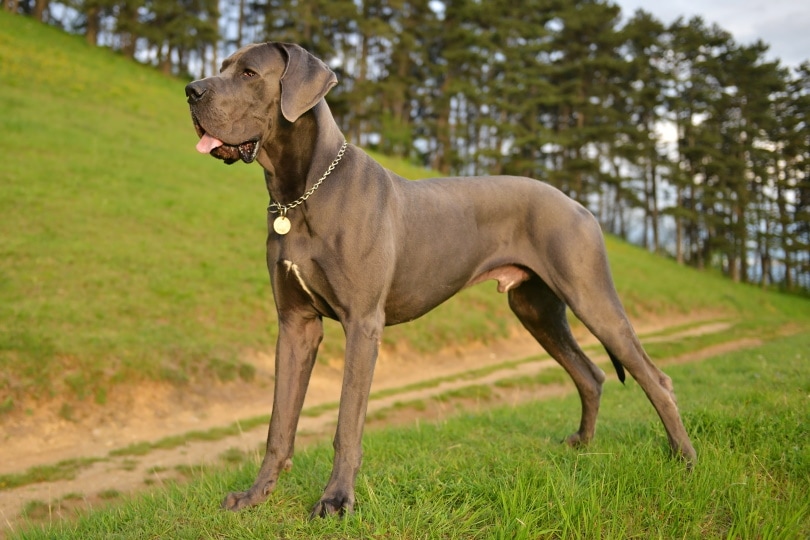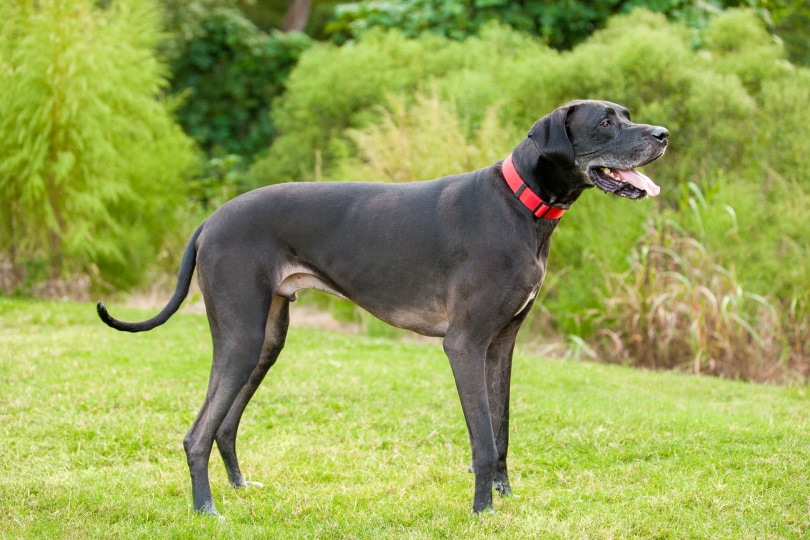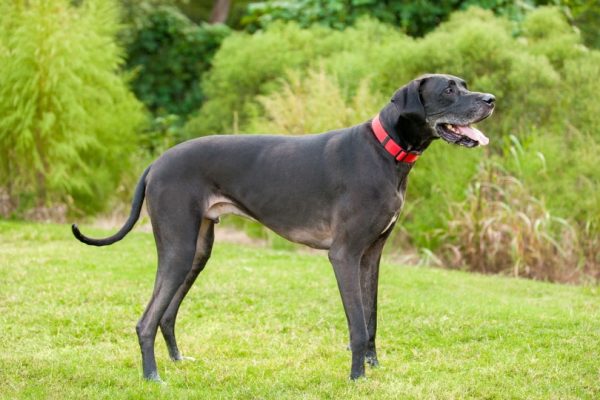Click Below to Skip Ahead
The Great Dane is a giant breed of dog that is known for being a gentle giant because of its seeming ability to understand that it is much larger than virtually everything around it. Even puppies are extremely large. Although every dog is a little bit different, it can be beneficial to have a general idea of how heavy and how tall your dog is likely to be.
Below, you will find a guide on the expected size of Great Danes at various milestones in their life, as well as factors that can influence their size.
Facts About Great Danes
- Great Danes are the Tallest Dogs in the World: Although some breeds may be heavier, and some may be stronger, the Great Dane is officially the tallest breed in the world, reaching a massive 32 inches at the shoulder. When they stand on their hind legs, they can dwarf their human owners.
- They Are Known as Gentle Giants: Despite their massive size, Great Danes are elegant and gentle. They are also very patient and are known to be good with children, puppies, and even kittens.
- They Need Some Exercise, But Not Too Much: The Great Dane does not need a lot of exercise, and too much can be bad for this huge breed. With that said, you will need to walk a Great Dane once or twice a day—always on a leash.
- They Have a Short Life Expectancy: Giant dog breeds tend to have shorter life expectancies than medium and small dogs, and this is true of the Great Dane, with a typical life expectancy of between 7–10 years.
Great Dane Size and Growth Chart
Generally, males weigh more and are taller than females, although even a female Great Dane is still a giant of a dog. By 10 months of age, your Dane will be close to its full size, although you can expect a little more growth until it reaches one year of age.
| Age | Weight Range | Length Range |
| 1 month | 6–8 pounds | 13–15 inches |
| 2 months | 20–30 pounds | 16–18 inches |
| 3 months | 30–45 pounds | 18–22 inches |
| 4 months | 45–65 pounds | 22–25 inches |
| 5 months | 65–85 pounds | 25–30 inches |
| 6 months | 75–100 pounds | 28–32 inches |
| 9 months | 80–120 pounds | 28–34 inches |
| 12 months | 90–140 pounds | 28–36 inches |
When Does a Great Dane Stop Growing?
Although a Great Dane can continue to grow until it is 18 to 24 months old, many Danes reach close to their full size by as early as 10 to 12 months of age. Most will not grow significantly larger once they do reach this milestone. You should ensure that you feed a healthy diet and provide regular exercise to ensure that your Great Dane does not put on too much weight beyond this point because an overweight Great Dane can suffer joint and muscular problems.

Factors Affecting the Size of Great Danes
As you can see from the chart above, while all Great Danes will grow to be giant dogs, there is some difference between the possible sizes they can reach.
- Genetics plays a huge role! If your Great Dane’s parents were both massive dogs that tipped the scales at the upper end of expected weight and height, you may reasonably expect your dog to reach a similarly large scale. Males are typically heavier and taller than females.
- Factors like stress and illness, especially from an infectious disease, when your Great Dane is a puppy and still in the development and growth stage, can hamper growth. Thankfully, panosteitis (growing pains) that typically affects large breed dogs, while painful, is self-limiting and does not lead to stunted growth; in fact, the pain associated with this condition typically indicates rapid bone growth and can be managed with medications that your veterinarian can prescribe.
- Weight, diet, and exercise influence the size of a dog. Ensure you feed an appropriate amount of food and avoid giving too many treats or too much human food. Also, ensure that your pup gets an appropriate amount of daily exercise to help ensure that it grows strong and healthy without becoming malnourished.
Ideal Diet for Maintaining a Healthy Weight
Great Danes can be fed dry or wet food or a combination of these food types.
- Wet food, although appetizing for your dog and formulated to meet daily dietary requirements, has a shorter shelf life, and the amount you need to feed will mean that it costs a lot of money for good quality food.
- Dry food needs to be accompanied by fresh drinking water, although this should always be provided anyway. And while it does keep longer and can be left in the bowl longer without going bad, it may not be as palatable to your dog as wet food is.
Complement this information by using our dog calorie calculator tool here:
The exact amount of calories an individual animal needs to maintain a healthy weight is variable and influenced by many factors including genetics, age, breed, and activity level. This tool is meant to be used only as a guideline for healthy individuals and does not substitute veterinary advice
How to Measure Your Great Dane
Having such a large breed can pose several challenges that you wouldn’t experience with a small dog. It is much easier to weigh a Chihuahua than it is a Great Dane. The general principle for weighing a dog is to weigh yourself on your bathroom scales and then weigh yourself while holding your dog. The difference between the two weights is the weight of your dog. While this might be possible for the first few months of a Great Dane’s life, you shouldn’t try picking up a 140-pound adult Great Dane. Have your vet weigh your dog or, if you use a grooming service, ask if they have scales to do this for you.
To determine the length of your dog, measure from the top of the neck where it meets the head down to the base of the tail.
Conclusion
The Great Dane is the world’s tallest dog breed, and while some breeds can end up weighing more, a maximum expected weight of 140 pounds means that the Great Dane is certainly not light. A dog of this size will interject itself into your daily life in a lot of ways, so make sure you understand the challenges that one presents. But if you do have room for a giant breed like this, the Great Dane is generally referred to as a gentle giant because it is loving, caring, and seems to appreciate its size.
Featured Image Credit: Tara Lynn and Co, Shutterstock










